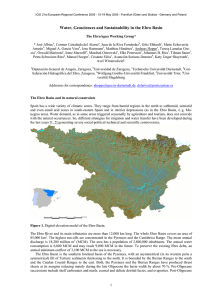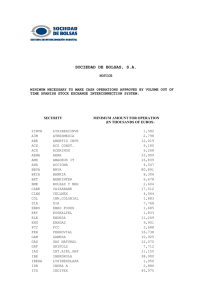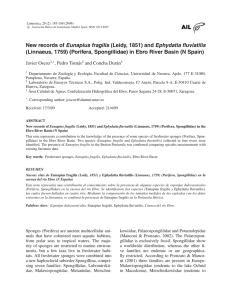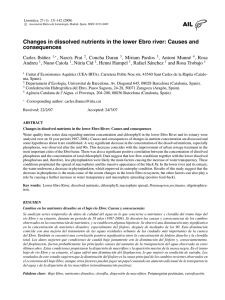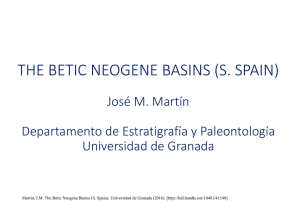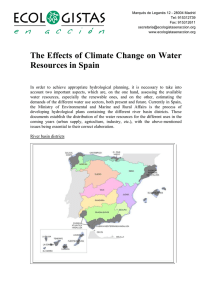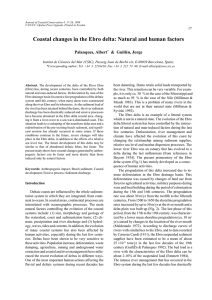Some considerations on the initiation of the present SE Ebro river
Anuncio
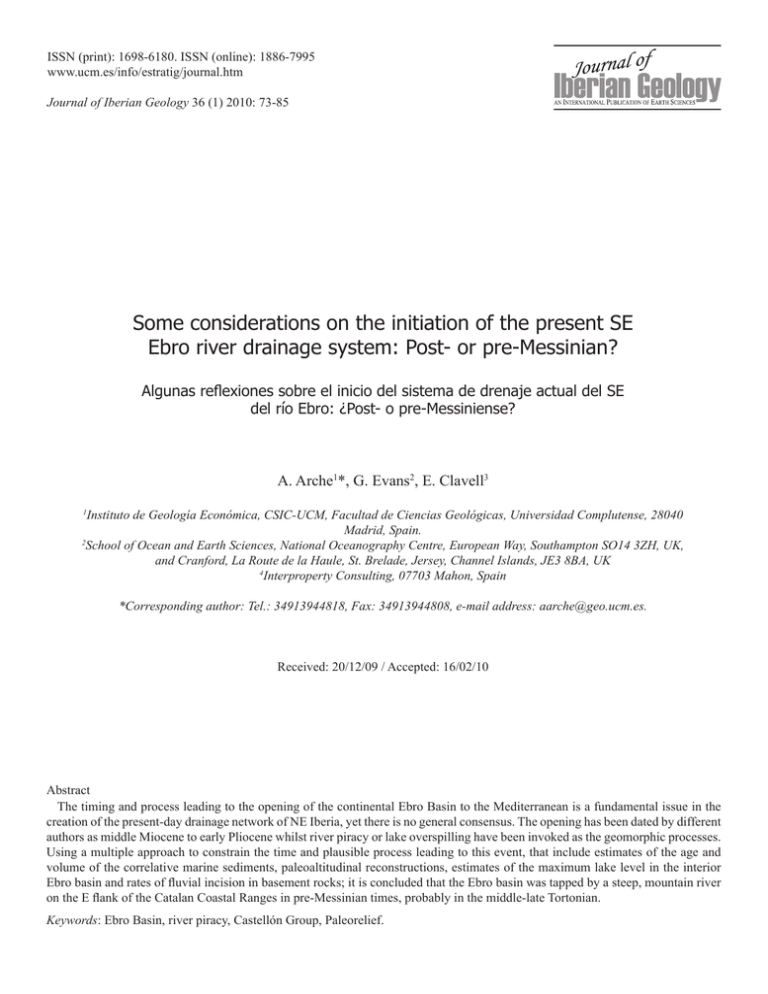
ISSN (print): 1698-6180. ISSN (online): 1886-7995 www.ucm.es/info/estratig/journal.htm Journal of Iberian Geology 36 (1) 2010: 73-85 Some considerations on the initiation of the present SE Ebro river drainage system: Post- or pre-Messinian? Algunas reflexiones sobre el inicio del sistema de drenaje actual del SE del río Ebro: ¿Post- o pre-Messiniense? A. Arche1*, G. Evans2, E. Clavell3 Instituto de Geología Económica, CSIC-UCM, Facultad de Ciencias Geológicas, Universidad Complutense, 28040 Madrid, Spain. 2 School of Ocean and Earth Sciences, National Oceanography Centre, European Way, Southampton SO14 3ZH, UK, and Cranford, La Route de la Haule, St. Brelade, Jersey, Channel Islands, JE3 8BA, UK 4 Interproperty Consulting, 07703 Mahon, Spain 1 *Corresponding author: Tel.: 34913944818, Fax: 34913944808, e-mail address: aarche@geo.ucm.es. Received: 20/12/09 / Accepted: 16/02/10 Abstract The timing and process leading to the opening of the continental Ebro Basin to the Mediterranean is a fundamental issue in the creation of the present-day drainage network of NE Iberia, yet there is no general consensus. The opening has been dated by different authors as middle Miocene to early Pliocene whilst river piracy or lake overspilling have been invoked as the geomorphic processes. Using a multiple approach to constrain the time and plausible process leading to this event, that include estimates of the age and volume of the correlative marine sediments, paleoaltitudinal reconstructions, estimates of the maximum lake level in the interior Ebro basin and rates of fluvial incision in basement rocks; it is concluded that the Ebro basin was tapped by a steep, mountain river on the E flank of the Catalan Coastal Ranges in pre-Messinian times, probably in the middle-late Tortonian. Keywords: Ebro Basin, river piracy, Castellón Group, Paleorelief. 74 Arche et al. / Journal of Iberian Geology 36 (1) 2010: 73-85 Resumen El momento de la apertura de la Cuenca del Ebro hacia el Mediterráneo y el proceso que la indujo representan aspectos clave en el desarrollo de la red de drenaje actual del NE de Iberia, aunque todavía no existe un consenso generalizado sobre los mismos. El momento de la apertura ha sido datado por diferentes autores desde el Mioceno medio al Plioceno inferior, mientras que una captura fluvial o el derrame del lago interior han sido propuestos como procesos geomórficos generadores. En este artículo hemos usado una técnica múltiple para precisar el momento y el proceso más verosímil que condujo a la apertura, que incluye estimación de la edad y el volumen de los sedimentos marinos correlativos al evento, reconstrucción paleoaltitudinal de las Cadenas Costero-Catalanas en dicho momento, estimación del nivel máximo del lago interior de la Cuenca del Ebro en dicho momento y la tasa aproximada de incisión del paleo-Ebro durante su periodo inicial en el basamento. Nuestra conclusión es que la Cuenca continental lacustre del Ebro fue capturada por un río corto y de elevada pendiente de la ladera Este de las Cadenas Costero-Catalanas antes del Messiniense, probablemente en el Tortoniense medio-superior. Palabras clave: Cuenca del Ebro, captura fluvial, Grupo Castellón, paleorelieve. 1. Introduction A striking feature of the drainage network of the Iberian peninsula is that whereas, other than some small coastal streams which flow to the north and south coasts, the main drainage is to the Atlantic; the only exception is the Ebro river which flows to the Mediterranean and whose drainage basin cuts deeply into the main watershed that separates the Atlantic flowing from the Mediterranean flowing rivers of the Iberian Peninsula (Figure 1). This anomaly is one which has occurred relatively recently in geologic history as in earlier times, during the Oligocene and the early-middle Miocene, the main flow of water and flux of sediments was to the west from this part of Iberia (Friend, 1996). For a considerable time, the explanation offered by Riba et al. (1983) that the development of the drainage network of the Ebro and its debouchment into the Mediterranean was due to some small E or SE flowing stream which had cut by headward erosion the Catalan Coastal Ranges during the low sea-level interval of the Messinian (Late Miocene), when it had increased energy/stream power. Evans and Arche (2002) questioned this interpretation and pointed out that large volumes of siliciclastic sediments of an older age (Tortonian, Late Miocene) already existed seawards of the modern Ebro delta. They suggested that the initiation of the Ebro drainage network was pre-Messinian, although it had continued to develop during and after the Messinian salinity crisis. They also suggested that the change of drainage and sediment flux from a westwards trend to that of today may have been aided by a reversal of the tilt of the Ebro basin from W-NW to E-SE in the final episodes of the collision of Iberia with Europe (Friend et al., 1996). García-Castellanos et al. (2003), using detailed reconstructions of the geomorphology of the Ebro basin and its Tertiary-Quaternary history and inverse modelling techniques, also came to the same conclusion that the volume of siliciclastic sediments of Miocene (pre-Messinian) age offshore of the Ebro delta demanded that the Ebro basin had been tapped by a E-SE flowing stream before the Messinian salinity crisis. Later, Babault et al. (2006), using rather similar techniques of geomorphological reconstruction as the latter, disagreed with both previous workers and claimed that the breaching of the Catalan Coastal Ranges and the release of the sediments of the Ebro basin and its flow to the Mediterranean had occurred much later. In this short paper, the views expressed by these three groups of authors are reviewed and further new, unpublished data by the authors on the areal extent and thickness of the Castellón Group, together with a reinterpretation of the opening process are provided which clearly indicate the pre-Messinian initiation of the present Ebro drainage system and its flux of the basin sediments to the Mediterranean. The quantitative aspects of the erosive process of the Ebro Basin after the opening to the Mediterranean are well expresed in García-Castellanos et al. (2003) and is not our goal to deal with this topic in this paper. 2. The presence or absence of a Miocene incised valley in the Ebro basin. A fundamental argument of Babault et al. (2006) was: “If the Ebro basin was connected to the Mediterranean before the Messinian Salinity Crisis, then a similar canyon to that of the Rhône would have been incised far inland within the basin” (i.e. into the Ebro basin). They concluded as such a canyon did not exist that the Ebro basin was not connected to the Mediterranean before the Messinian Salinity Crisis. Furthermore, they claimed that this had not occurred until Pliocene times. It is true that some rivers such as the Rhône excavated a deep canyon which reached into the hinterland during the Messinian Salinity Crisis; this was at least 2,000 m deep Arche et al. / Journal of Iberian Geology 36 (1) 2010: 73-85 A B Fig. 1. A. The drainage basins of the Iberian Peninsula. B. The lower course of the Ebro River across the Catalan Coastal Ranges. Fig. 1.- A) Las cuencas de drenaje de la Península Ibérica. B) El curso inferior del río Ebro a través de las Cordilleras Costero-Catalanas. and extended 300 kilometres inland of the present day river mouths and was achieved in a very short period of time (less than a 1Ma.) (Ryan, 1976; Clauzon, 1978; Lofi et al., 2003; Mocochain et al, 2006; Loget et al, 2006; 75 Lofi and Berné, 2008). A similar situation occurred in the case of the Nile which is a comparable case (Said, 1981; Aal et al, 2001; El-Ella, 1990). However, it should be noted that this particular feature of the Rhône was largely eroded into unconsolidated older Tertiary sediments of an Alpine foreland basin by a river which had its drainage parallel to the main tectonic lineament of the area. However, the Ebro river cannot be compared with either the Rhône or with the Nile rivers because both of these two had well-developed fluvial networks draining extensive drainage basins before the Messinian Salinity Crisis, probably at least since the early Miocene (Besson et al., 2005; Maillard et al., 2006; Said, 1981) and were able to react to substantial sea-level drops during the Miocene to carve out deep incised valleys. In contrast, the Ebro River was non-existant before the Tortonian and probably was merely a juvenile, far from its equilibrium profile and steep mountain river for some time afterwards, lacking the stream power of the other big Mediterranean rivers. Also, in contrast to the Rhône, the embryonic protoEbro flows perpendicular to the tectonic grain during its initiation and it had to cut across the high and rising hard Mesozoic-Palaeozoic rock basement of the Catalan Coastal Ranges, and, unlike the Rhône, which flows roughly parallel to the Alpine tectonic lineations of the area, its course was transverse to the main tectonic trend with no obvious control by NW-SE faults or by fold axes. It was a bedrock river, as defined by Whipple (2004) and Turowski et al. (2008). The rates of incision of bedrock channels quoted in the literature range from 0.5 to 100 cm/thousand years (Wohl, 1999; Tinkler and Wohl, 1998)with the larger values being observed only in the Himalayan rivers, which are by far the most erosive today and are characteristic of networks much larger than the Ebro river. Fluvial incision by bedrock rivers is driven by stream power, which is proportional to the product of slope and discharge and inversely proportional to river width (Rosenbaum and Anderson, 1994; Burbank et al, 1996; Carling, 2006). It is controlled by climate (precipitation), tectonics (active or not) and surface process dynamics (slope gradient creation and preservation) (Seong et al., 2008, 2009; Godard and Catin, 2004). River discharge is an especially important factor because it controls the potential to remove large volumes of sediments over long periods of time. In extreme cases, like in the Braldu river, Pakistan, this efficiency combined with active tectonics leads to incision rates of 22.9-29 mm/a. (Seong et al., 2009). However, the proto-Ebro could not be compared with this Himalayan river as its discharge was several orders smaller. High rates of incision have been reported from mountain 76 Arche et al. / Journal of Iberian Geology 36 (1) 2010: 73-85 ranges much smaller than the Himalayas, like the Taiwan Central Range (Hovius et al., 2000; Lin et al., 2008), due to very intense typhoon precipitation and earthquake activity, a very different geomorphic regime to the one in the late Miocene in the NE of Iberia, an extensional and dry area, and not a compressional one as Taiwan. Assuming a low to medium rate of incision for the proto-Ebro, i.e. that most probable for a small steep Miocene mountain river, it would have taken between 10 to 30 Ma to cut a channel through a hard rock mountain chain with a relief of about 1.5 kilometres or more. Thus it would have been difficult for the Ebro to have sufficient time to have cut across a mountain range and to have extended its course into the softer sediments of the Ebro basin in the time interval suggested by Babault et al. (2006) ie., from the Pliocene to the Quaternary (about 5 Ma.). The lower reach of the present-day Ebro river is bordered by a relief which is higher than 1,400 m on its western bank (Sierras de Beceite) and more than 1,200 m on its eastern bank (Sierra del Caró and Sierra del Montsant). Today, only the lowermost reach of the Ebro river is near sea level and close to a equilibrium longitudinal profile, indicating a long period of time with a non-equilibrium longitudinal profile and slow erosion through the Catalan Coastal Ranges that formed a marked knickpoint in the river for a long period. Erosion is still active in the medial and proximal areas of the Ebro river, as demonstrated by its deep gorges and narrow, entrenched reaches. Similarly, it is obvious that the proto-Ebro river had insufficient power to cut across the high relief of the Catalan Coastal Ranges and adjacent coastal margin in the short interval of Tortonian –Early Messinian times (less than 1 Ma.) because of its likely small discharge and hence small erosive power, so the comparison with the Miocene-Pliocene story of the Rhône valley is not valid because the latter had a much larger catchment and discharge. Clearly, the Ebro could not have cut the indurated basement to its present position in the short available time from the Pliocene to the Quaternary as suggested by Babault et al. (2006). However, on the other hand as there is an almost total absence of detailed seismic profiles in the geologic literature that extends to the base of the Castellón Group, the existence of older incised valleys at this surface cannot be completely overruled. (see the review by Clavell and Berasategui, 1991). The pre-Messinian sedimentary record offshore of the present day Ebro delta (the Castellón Group) is shown with some detail in Maillard et al. (2006) and shows from base to top a clear major regressive trend in response to a sea-level fall that started during the Tortonian, punctuated by some minor events which produced internal ero- sive surfaces; however, there are no submarine canyons associated with the Castellón Group. Hence, the absence of a late Miocene deeply incised valley extending into the Ebro basin from the mouth of the present-day river as found in the valley of the Rhône is not a valid reason for denying connection of the former to the Mediterranean in Tortonian-Early Messinian times or during the Messinian Salinity Crisis, as the erosion of the indurated core of the Catalan Coastal Ranges by a river i.e. the ancestral Ebro river, flowing across the tectonic grain , which was only a small mountain river with both low initial runoff and low stream power would have been several orders of magnitude smaller than the Rhône fluvial system at that time. The only deep incised valley or canyon on the Ebro occurs in the present-day lower valley, which is entrenched into the core of the Catalan Coastal Ranges and into the continental lacustrine sediments of the eastern Ebro basin. The absence of significant lateral hillslope landsliding in the Ebro valley during its geological evolution precludes any rapid river downcutting period as such in the present day Himalayan rivers (Burbank et al., 1996; Seong et al., 2009) or to the syn-Messinian Salinity Crisis downcutting of the Rhône river paleocanyon (Lofi et al., 2005, Loget et al., 2006), needed to create the present day topography of the Ebro lower reaches in the short time since the Pliocene as proposed by Babault et al. (2006). 3. The various quantification models of erosion The latest discussion of the initiation of the present Ebro drainage system was that of Babault et al. (2006) which was based on a numerical quantification model of the sedimentation-erosion processes. Some of the assumptions of these writers are difficult to understand, e.g.: why should the Ebro basin be “filled to the brim” when it was tapped by the regressive erosion from the Mediterranean side of the Catalan Coastal Ranges? The infilling of the lacustrine Ebro basin and the regressive erosion of the ancestral Mediterranean Ebro river are independent processes. Also, no reasons are offered as to why one of their experiments (Nº 3) does not predict a deeply incised valley after the opening of the Ebro basin whilst the other three did; nor do the authors explain why the results of that particular experiment were discarded without any further explanation. In fact, a similar numerical model to that of Babault et al. (2006) had been previously used by García-Castellanos et al. (2003) to determine the date of the commencement of the SE flow of the Ebro river, but this came to a very different conclusion than that of the former writers. However, other than a cursory discussion Arche et al. / Journal of Iberian Geology 36 (1) 2010: 73-85 on the initial parameters used in both cases, no detailed explanation of the disagreements was offered by Babault et al. (2006), so the reader is left in doubt whether the differences between the two analyses lie in the methods of calculation (the numerical models) or in the initial data sets (the regional geology). Basically, the earlier study of García-Castellanos et al. (2003) agreed with the conclusions of Evans and Arche (2002) although the latter had used different arguments relying entirely on the consideration of the stratigraphic data. This coincidence poses serious doubts on the validity of the results of the numerical models of Babault et al. (2006) for the Ebro basin and its opening to the Mediterranean. 4. The paleo-altitude of Catalan Coastal Ranges A causal factor which is pertinent, indeed crucial, but usually overlooked in this discussion, is the paleo-altitude of the Catalan Coastal Ranges during late MiocenePliocene. This has to be considered, and it was overlooked by Babault et al. (2006). In any evaluation of the viability of the opposing lake overfill hypothesis as opposed to a Mediterranean river piracy hypothesis for the timing of the opening of the Ebro basin to the Mediterranean Sea. At the end of the Pyrenean compressive phase, in approximately late Oligocene times, the altitude of the Catalan Coastal Ranges was estimated by López-Blanco et al. (2000) to be 700-1,100 m. The opening of the Gulf of Valencia along its SE margin took place during an active extensional phase in the early-middle Miocene and this added at least a further 1 km uplift to the Catalan Coastal Ranges because of a rift footwall uplift (GarcíaCastellanos et al., 2003). The NE-SW fault systems along the Barcelona, El Camp and Vallés-Penedés lineaments were active during the middle-late Miocene, with positive vertical displacements of 1-2 kilometres (Roca et al., 1999). Differential movement between the subsiding Gulf of Valencia trough and its raising shoulders in The Catalan Coastal Ranges in this period ensured its role as a physical barrier which first closed the lacustrine Ebro basin and later formed a fundamental knickpoint on the proto-Ebro river. The magnitude of the unroofing of these ranges in the Miocene-Quaternary interval was estimated by JuezLarré and Andriassen (2002) to be about 2 km. As their present-day topography reaches 1,400-1,500 m above sea level, the paleo-relief before the opening of the Ebro basin would have been at least, the unroofed value mentioned above, i.e., about 500 m above its present height. Today, only in its lower parts, where its course is close to sea-level, has the Ebro River managed to cut deeply into 77 the Mesozoic-Paleozoic basement. It is true that exhumation, i.e., the displacement of rocks with respect to a fixed surface and the rate of exhumation or rate of overburden removal by tectonic processes (England and Molnar, 1990; Molnar and England, 1990) is not equivalent to paleotopographic uplift, but it can be considered almost equivalent in areas of low to moderate erosion as is the case of the Catalan Coastal Ranges. During the mid-Miocene to Quaternary interval, the Ranges were increasing actively and hence the relief increased due to lithospheric mantle thinning and subsequent increased heat flow in the region adjacent to the area of the Gulf of Valencia rifting (Cabal and Fernandez, 1995; Vergés and Sábat, 1999). This reinforces the hypothesis of Evans and Arche (2002) of a high late Miocene paleo-altitude of the Catalan Coastal Ranges. This continued uplift since mid Miocene times is demonstrated by the presence of late Pliocene (aprox. 2.5 M.a. old sediments) at heights of 80-110 metres above sea level in the locality of Papiol, near Barcelona (IGME, 1975; Suc et al., 1992) and at heights of 100-120 metres above sea level in the locality of Casas del Rantxero (Tarragona), in the lower reaches of the present day Ebro river (Maldonado et al., 1979). Similar dynamic topographical processes have been described by Lewis et al. (2000) in the NE part of Catalonia, in the eastern part of the Pyrenees which resulted in tectonic and erosive denudation of the basement and the capture by Mediterranean rivers of interior basins leading to the creation of a major late Miocene depocentre offshore Girona (García-Castellanos et al., 2003) but this topic is not addressed in this paper. 5. Sources of the siliciclastic Tortonian Castellon Group Evans and Arche (2002) considered that the Tortonian (late Miocene) submarine siliciclastic wedge offshore of the Catalan coast, known in the literature as the Castellón Group (Clavell, 1992; Martínez Del Olmo, 1999), represented the marine accumulation of sediment which has resulted from the breaching of the Catalan Coastal Ranges and the subsequent release to the adjacent Mediterranean of sediments from the Ebro basin by a protoEbro fluvial network (Figure 2). This suggestion was dismissed by Babault et al. (2006) on the grounds that these authors had not presented any estimation of its volume. Instead, they preferred to invoke the previous hypothesis of Bartrina et al. (1992) that suggested that these sediments came from erosion of the onshore Miocene graben sediments of the eastern side of the Arche et al. / Journal of Iberian Geology 36 (1) 2010: 73-85 Pliocene Pleistocene Holocene QUATERNARY 78 Ebro Sands EBRO GROUP 1.8 Ebro Clays 5.3 7.2 Miocene Tort. 11.6 CASTELLÓN GROUP Castellón Sands Serr. Lang. M3 M2 M1 16.0 Burd. 20.4 Castellón Clays M4 13.6 Aquit. Oligocene CENOZOIC Mess. ALCANAR GROUP 23.0 M0 MESOZOIC Fig. 2. Stratigraphic section of the Cenozoic sediments of the Valencia Trough (modified from Clavell and Berasategui, 1991 and Meléndez-Hevia and Álvarez del Buergo, 1996). Fig 2.- Esquema estratigráfico de los sedimentos Cenozoicos del Surco de Valencia (Modificado de Clavell y Berasategui, 1991 y Meléndez-Hevia y Álvarez del Buergo, 1996). Catalan Coastal Ranges, which had been partially eroded by short, active mountain rivers during this period. However, it is evident since the publication of the works of Dañobeitia et al.1990) and Ziegler (1988) that active continental slope and delta progradation had taken place along the Catalan coastline prior to the Messinian Salinity Crisis. Martínez del Olmo (1996) interpreted the Castellón Group as a vertically prograding siliciclastic turbiditic to deltaic system in which the distal part is represented by the Castellón Clays and the prograding proximal part by the Castellón Sands, both of which lie, of course, beneath the erosive surface found at the base of the Messinian marine siliciclastic and evaporitic sediments. Also, earlier sedimentary syn-rift siliciclastic sequence, the Cambrils Alcanar) Group, was identified beneath the Castellón group by Clavell and Berasategui (1991), dated as Langhian/Serravallian (Early Miocene) in the initial Tarragona rift trough. This is overlain unconformably by the younger Castellón group. It is a sedi- mentary unit derived from local sources along the eastern margins of the rising Catalan Coastal Ranges as shown by the presence of Paleozoic pebbles originating from the Castellón sector; however these pebbles are absent from the Castellón Group. García-Castellanos et al. (2003) demonstrated that the volume of post-Messinian sediments which was delivered to the Mediterranean by the Ebro river is considerably smaller than the estimated amount that posssibly could have been supplied by erosion of the Ebro basin and surrounding mountain ranges during the available time suggested by Bartrina et al (1983) and Babault et al (2006), thus clearly indicating that the opening and correlative sediment input into the Mediterranean must have occurred prior to the Messinian Salinity Crisis. This conclusion seems undeniable and with which the writers agree. The Castellón Sands do not show in seismic profiles true clinoform delta geometries and can probably best interpreted as a broad, multichannel distal Arche et al. / Journal of Iberian Geology 36 (1) 2010: 73-85 fluvial plain passing longitudinally into a siliciclastic coastal plain- continental shelf complex when the siliciclastic input from the Ebro basin was small and was reworked by the strong longshore marine currents which existed during the Tortonian in the Mediterranean. In order to answer the criticisms of Babault et al (2006) as to the lack of quantification in the Evans et Arche (2002) paper of the volume of the Castellón Group and its detailed regional distribution, two updated isopachyte maps are presented here (Figures 3, 4 and 5), one of the proximal (Castellón Sands), a second of the distal (Castellón Clays) facies and a third summing up the thickness of the whole Castellón group (proximal and distal facies). They are based on commercial borehole data of Clavell (1992), Clavell et al (2003) and Martínez del Olmo (1996). These maps clearly show two linked depocenters: one in front of the present-day Ebro River which extends to the SW towards the Valencia offshore area and a second situated to the NE along the Girona coastline. Both are clearly delineated, but only the southern one concerns this article. The depocenter of the proximal Castellón Sands is subdivided in two linked maxima (Figure 3), probably due to strong SW dispersal of sediment parallel to the coastline by strong longshore marine currents, such as occur today These sediments are interpreted as distal fluvial plain-coastal deposits grading laterally into a siliciclastic continental shelf wedge of siliciclastic sediment that prograded towards the E-SE. The depocenter of the distal Castellón Clays (Figure 4) shows a similar geometry in a more distal position and may extend towards the SW beyond Valencia and are interpreted as continental slope-continental rise turbidite deposits fed from the shallower continental shelf area to the W. The minimal area covered by the deposition of the Castellón Group in the Ebro-Valencia area is 3,000 sq Kms and probably reaches 5,000 sq Kms or more if the SW area in front of Valencia is considered; it has a maximum total thickness of about 2,200 m. Unfortunately, the SW part of the isopachyte maps is not complete because of difficulties in the interpretation of the available borehole logs in the distal Valencia area. These maps are in good agreement with the one presented by GarcíaCastellanos et al. (2003) for the whole of the Castellón Group. The minimum estimated volume of the Castellón Group from the isopachyte maps is 7,000km3, possibly reaching 10,000 km3 if the unmapped area to the SW is taken into account. This volume is clearly much too large to have been supplied exclusively by erosion of local sources in 79 the Miocene grabens of the eastern flank of the Catalan Coastal Ranges by small local mountain rivers as suggested by Bartrina et al. (1992) and Babault et al. (2006). Roca et al. (1999) and Cabrera and Calvet (1996) demonstrated that the main Miocene grabens in the Catalan Coastal Ranges (the Vallés-Penedés graben and the El Camp graben) were active depositional areas during the Oligocene and the Miocene (at least until the Messinian), accumulating more then 2,000 metres of shallow marine and continental sediments, without any trace of major internal erosional surfaces or angular unconformities and most of them still in place, i.e.: no erosion took place in these grabens during the late Miocene period of time that could have released substantial amounts of sediments from these basins to the marine depocenters along the catalan Mediterranean coastal platform (the Castellón Group), so they can be dismissed as potential, important sources of sediments in this period. Furthermore, even if the total volume of the infill of these Miocene basins is considered, it is less than the estimated volume of the Castellón Group (Martínez del Olmo, 1996). The only available alternative for the main source of sediments was the tapping of the infill of the lacustrine Ebro basin. This was not a catastrophic event, because there would have been a time-lag between the opening and the knickpoint created took a long time to be developed completely and to be eroded. The maximum efficiency of an incision in this type of captures was probably reached long after the initial breaching took place (Kooi et Beaumont, 1996). It is of interest to note that a coeval depocenter was created to the NE (Lewis et al., 2000; García-Castellanos et al., 2003) (Figures 3 and 4) fed by the ancestral Ter-Muga-Fluviá-Llobregat river networks. These rivers captured the sediments of an interior drainage basin by headward erosion of some small Mediterranean coastal rivers (Vergés et al, 1996). Again, a comparable volume of sediments to the Castellón Group occurs in this area, beneath the Messinian basal unconformity, i.e., it was deposited before the initiation of the Messinian Salinity Crisis. In addition, the volume calculated for the SW depocenter in the Ebro-Valencia area would almost certainly be increased if the pre-Messinian erosion of its topmost part had been taken into account. However, even a rough estimate of the volume of this missing sedimentary record at the top of the Castellón Group cannot be made, in spite of the recent works by Frei-Martínez et al. (2004) and Bertoni and Cartwright (2005) which reconstructed the basal Messinian Unconformity in detail. 80 Arche et al. / Journal of Iberian Geology 36 (1) 2010: 73-85 Fig. 3. Isopachyte map of the Castellón Sands. They are interpreted as proximal coastal and shelf sediments prograding to the East. The SW depocenter is the only one related to this paper. Fig. 3.- Mapa de isópacas de las Arenas de Castellón. Se interpretan como sedimentos costeros y de plataforma marina proximal programando hacia el Este. Este artículo sólo se ocupa del depocentro SW. 6. River piracy vs. lake overspill There are suggestions in the papers of Riba et al. (1983), Serrat (1992) and García-Castellanos et al. (2003) that possibly both lake overfilling at the Ebro basin as well as river capture led to the ultimate flux of sediment to the Mediterranean. The mechanism of the opening of the Miocene lacustrine Ebro basin to the Mediterranean has been discussed over many years since the seminal observation of Riba et al. (1983), who stated: “At the end of the Miocene…it is possible that the waters of the (Ebro) depression started to flow towards the sea because of the cessation of the evaporite sedimentation”, and added: “The lower Ebro, no doubt, captured the drainage network of the middle Ebro interior basin”. They related this event to the drop of sea-level associated to the Messinian Salinity Crisis (about 7 Ma.). This river piracy hypothesis was widely accepted in later literature (see a complete discussion in Evans and Arche, 2002 and García-Castellanos et al., 2003). A slightly different mechanism, albeit which had occurred at a slightly different time, was proposed by Evans and Arche (2002): i.e. piracy by a small Mediterraneanflowing stream. However, they suggested that this was reinforced by the effects of a regional tilting to the E-SE of NE Iberia during the Tortonian (roughly between 12 Ma. and 8 Ma.). The authors compared this tilting to that which had occurred between the deposition of the Lower and the Upper Alpine Molasse of the foreland basin in Switzerland (Homewood et al., 1986). Also, perhaps the southward shift of the late Eocene-Oligocene Ebro basin depocenter shown by Allen and Mange (1982) indicates the early stage of such tilting. Arche et al. / Journal of Iberian Geology 36 (1) 2010: 73-85 81 Fig. 4. Isopachyte map of the Castellón Clays. They are interpreted as distal continental slope – continental rise turbidite deposits . The SW depocenter is the only one related to this paper. Fig. 4.- Mapa de isópacas de las Arcillas de Castellón. Se interpretan como sedimentos de talud continental y turbiditas de borde precontinental. Este artículo sólo se ocupa del depocentro SW. A combined mechanism for the opening of the Ebro basin during the Tortonian was invoked by García-Castellanos et al. (2003). They suggested lake capture caused by one of the newly initiated Mediterranean-flowing streams together with coeval overfilling of the lacustrine Ebro basin during a short period of wetter climate in the late Neogene, before the Messinian Salinity Crisis. The lake level was then around 1,050 m above sea level. These authors placed the age of the tapping of the lake sediments by a small Mediterranean-flowing stream between 13 M.a. and 8.5 Ma. for geological considerations. Their numerical modelling indicated that the initiation of the flow towards the Mediterranean was at about 11.5 Ma. In contrast, Babault et al. (2006) suggested river capture of an Ebro basin which was “filled to the brim” in Pliocene times. However, a lacustrine basin filled to this level would have been extremely unstable: either it would have led to catastrophic flooding or it would have receded to lower levels depending on the water influx and evapotranspiration equilibrium. A prolonged period of time of stable total infilling of the lacustrine basin without overspilling or retreat is very improbable. A key factor in comparing the viability of lake-overflowing versus tapping by small Mediterranean-flowing stream hypothesis is the absolute lake level when compared to with the estimated paleo-topography of the Catalan Coastal Ranges at that time, as well as climatic considerations. Lacustrine evaporite deposition ended in the Ebro basin (and in the coeval Tagus basin) at about 15.5 M.a. (Mid Aragonian stage=basal Serravallian stage) (Calvo et al., 1993) due basically to increased precipitation that diluted the brines in the closed lacustrine basins during the early late Miocene. This transition is a consequence of a global-cooling climatic event marked by 82 Arche et al. / Journal of Iberian Geology 36 (1) 2010: 73-85 Fig. 5.- Isopachyte map of the whole of the Castellón Group. Fig. 5.- Mapa de isópacas del conjunto del Grupo Castellón. a major isotope shift, increase in Antractica ice volume, temperature cooling and increased precipitation (Hilgen et al. 2009). Sea-level started to fall about the same time, culminating in a major sea-level drop at about 10.5 M.a., when the Mediterranean was still fully connected to the Atlantic (Lourens et al., 2005). A fall of sea-level caused an increase of stream power in the small, steep mountain rivers on the eastern flank of the Catalan Coastal Ranges and the water-level in the lacustrine Ebro basin also increased; a process that, presumably, increased the amount of subterranean flux of water through karstic conduits to the same rivers. The youngest lacustrine sedimentary unit, the Alcubierre Fm, preserved in the Ebro basin crops out in the Sierra de Alcubierre, 50 km east of Zaragoza, in the locality of San Caprasio, at an altitude of 820 m above sealevel (Pérez-Rivares et al., 2002). It has been dated as late Aragonian=lower Tortonian (about 13 Ma.) by means of biostratigraphic and magnetostratigraphic data; however, the top of the unit has been eroded. This unit lies on an erosive basal surface cut into the underlying Sariñena Fm, of middle Miocene age. The presence of such a regional erosive unconformity and other similar, older ones, in the Miocene sedimentary record of the Ebro basin were interpreted as marking periods of tectonic unstability by Calvo et al. (1993), Pérez-Rivares et al.(2002) and Domingo et al. (2007) among others. The rate of deposition of the Alcubierre Fm can be calculated from the preserved record to have been approximately 6-8 cm per thousand years. Using the data of García-Castellanos et al. (2003), which assumed an altitude of about 1,050 m for the top of the lacustrine sediments just before the opening of the Ebro basin, as well as taking into account the fact that the base of the Messinian has been dated as 7.5 Ma (Gradstein et al, 2005), and furthermore that the opening occurred before that time, the 1,050 m level was reached at approximately 9-8,5 Ma, i.e. at the top of the Tortonian stage. As has been argued previously (Evans and Arche, 2002 and this paper), the paleo-altitude of the Catalan Coastal Arche et al. / Journal of Iberian Geology 36 (1) 2010: 73-85 Ranges was probably in excess of 1,500 m at that time; therefore it would have been impossible for the lake waters to have overflowed the mountainous barrier. Only the breaching of this range and the subsequent tapping of the basin by a small, steep Mediterranean river in late Tortonian times remain as a reasonable hypothesis for the opening, at a slightly later age than that proposed by García-Castellanos et al. (2003), but much earlier than that proposed by Babault et al. (2006). As to the argument of Babault et al. (2006) that the Messinian drainage systems fed sediments to the Mediterranean in the Gulf of Lion without any change in their drainage basins is no argument against the initiation of the Ebro system as a “specific sedimentary event”. The situations were quite different. The rivers such as the Rhône and the Nile were not bordered landwards by an elevated closed basin containing a huge volume of sediment which could not be released until tapped by headward erosion. In the case of the Ebro, similar streams as those flowing to the Gulf of Lion supplied sediment to the Catalan coastal margin (Clavell and Berasategui, 1991). However, it was the presence of a land-locked, massive accumulation of sediment which could not be released until a connection with the Mediterranean had been made which made the initiation of the Mediterranean-flowing Ebro river such an important “specific event”. Other additional factors, which do not appear to have been considered before should be made on the development of the Mediterranean flowing drainage system. The development of groundwater and karst networks are in some cases very active agents in landscape evolution and an important component of river discharge, although this is usually underestimated (Nash, 1997). These processes were very important in the Rhône fluvial system during the Messinian Salinity Crisis (Mocochain et al., 2006). As mentioned previously, the progressive climatic cooling and increased precipitations since the Serravallian (early late Miocene) presumably also increased the volume of subterranean water diverted into the mountain rivers of the eastern side of the Catalan Coastal Ranges via the karstic systems of the calcareous Mesozoic cover of these ranges. As the Mesozoic cover of the Catalan Coastal Ranges consists essentially of Jurassic and Cretaceous carbonates, a perched lacustrine water body in the Ebro basin may have fed a well-developed karstic system in these rocks and thus would have increased the discharge of the mountain rivers flowing to the Mediterranean and, therefore, also increased their stream power. The headward erosion would have created an amphitheatre-headed valley which retreated actively, across the mountain chain. 83 As the deposits of the Alcubierre Fm are not horizontal, but have dips of 2-3 degrees in broad folded structures (Costa et al., 1998), the suggested syn-sedimentary tilt of the basin to the E-SE would again have increased the flow of water seawards i.e. to the East. In summary, the most probable mechanism for the opening of the Ebro basin to the Mediterranean was the breaching of the Catalan Coastal Ranges and the tapping of the Ebro basin sediments by a small mountain river on the SE side of the Range at approximately 9-8,5 Ma; this together with a contribution of the subsurface flow of subterranean waters at its head was probably enhanced by a regional tilt of NE Iberia to the east-southeast. The mere overspilling of a lake is not considered a plausible hypothesis for this important event. Acknowledgements The authors thank Paul Bernier and especially Jean Pierre Suc for their help with the French literature during the preparation of this paper. Also Modesto Escudero and Juan Pedro Rodriguez-López are thanked for his help with the electronic processing of the figures. The referees Joseph Cartwright and Stuart Jones are also thanked for their constructive remarks and comments which greatly improved a previous version of the paper. References Aal, A.A., El Barkoozy, A., Gerrits, M., Meyer, H.J., Schwander, M., Zaki, M. (2001): Tectonic evolution of the Eastern Mediterranean basins and its significance for hydrocarbon prospectivity of the Nile deepwater area. GeoArabia, 6: 363384. Allen, P., Mange, M,. (1982): Sediment dispersal and paleohydraulics of Oligocene rivers in the eastern Ebro basin. Sedimentology 29: 705-716. Babault, J., Loget, N., Van den Driessche, J., Castelltort, S., Bonnet, S., Davy, S., (2006): Did the Ebro basin connect to the Mediterranean before the Messinian salinity crisis? Geomorphology 81: 155-165. Bartrina, M.T., Cabrera, L., Jurado, M.J., Guimerá, J., Roca, E., (1992): Evolution of the central Catalan margin of the Valencia Trough (Western Mediterranean). Tectonophysics 203: 219-247. Bertoni, C., Cartwright, J. (2005). 3D seismic analysis of slope-confined canyons from the Plio-Pleistocene of the Ebro Continental Margin (Western Mediterranean). Basin Research, 17: 43-62. Bertoni, C., Cartwright, J. (2006): Controls on the basin-wide architecture of late Miocene (Messinian) evaporites on the Levant margin (Eastern Mediterranean). Sedimentary Geology, 188-189: 93-114. 84 Arche et al. / Journal of Iberian Geology 36 (1) 2010: 73-85 Besson, D., Parize, O., Rubino, J.L., Aguilar, J.P., Aubry, M.P. (2005): Un réseau fluviatile d’âge Burdigalien terminal dans le Sud-Est de la France:remplissage, extensión, âge, implications. C. R. Geosciences, 337: 1045-1054. Burbank, D.W., Leland, J., Fielding, E., Anderson, R.S., Brozovic, N., Reid, M.R., Duncan, C. (1996): Bedrock incision, rock uplift and threshold hillslopes in NW Himalayas. Nature, 379, 505-510. Cabal, J., Fernandez, M., (1995): Heat flow and regional uplift at the NE border of the Ebro basin, NE Spain. Geophysical Journal International, 121: 393-404. Cabrera, L., Calvet, F. (1996): Onshore Neogene record in NE Spain: Vallés-Penedés and El Camp half grabens. In: P.F.Friend, C.J.Dabrio (Eds.): Tertiary basins of Spain, 97105, Cambridge Uniersity Press. Calvo, J.P., Daams, R., Morales, J., López-Martínez, N. (1993): Up-to-date Spanish continental Neogene synthesis and paleoclimatic interpretation. Revista Sociedad Geológica España 6: 29-40. Carling, P. (2006): The hydrology and geomorphology of bedrock rivers. Geomorphology: 82, 1-3. Clauzon, G., (1973): The eustatic hypothesis and the prePliocene cutting of the Rhône valley. Initial Reports, DeepSea Drilling Project 127: 1-30. Clavell, E., (1992): Geologia del petroli de les conques terciaries de Catalunya. Ph.D. Thesis (Unpublished), Universitat Barcelona, 538 p. Clavell, E, Berasategui, X. (1991): Petroleum geology of the Gulf of Valencia. In: Generation, accumulation and production of Europe’s hydrocarbons (A.M.Spencer, Ed.), 355368, Oxford University Press. Clavell, E., Klimowitz, J., Hernandez, E. (2003): The Gulf of Valencia: exploration review and future trends. AAPG International Petroleum Conference Exhibition, Barcelona, Abstracts, 69-78. Costa, J.M., Ramírez, J.I., Navarro, J.J. (1998): Mapa Geológico de España 1:50,000, Hoja 356, Lanaja, 1-65. Instituto Geológico Minero España. Cravatte, J., Dufaure, P., Prim, M., Rouaix, S. (1974): Les sondages du Golfe de Lyon: stratigraphie, sédimentologie. Notes Mémoires Compagnie Francaise des Pétroles: 6, 209274. Dañobeitia, J., Alonso, B., Maldonado, A. (1990): Geological framework of the Ebro continental margin and surrounding areas. Marine Geology 95: 265-287. Domingo, M.S., Alberdi, MT., Azanza, B. (2007): A quantitative biochronological ordination for the Upper Neogene mammalian localities of Spain. Paleogeography, Paleoclimatology, Paleoecology 255: 361-376. El Ella, R.A. (1990): The Neogene-Quaternary section in the Nile Delta, Egypt: geology and hydrocarbon potential. Journal Petroleum Geology, 13: 329-340. England, P., Molnar, P. (1990): Surface uplift, uplift of rocks and exhumation of rocks. Geology, 18: 1173-1177. Evans, G., Arche, A.(2002): The flux of siliciclastic sediment from the Iberian Peninsula with particular reference to the Ebro. In: Jones, S.J., Frostick, L.E. (Eds.): Sediment flux to basins: causes, controls and consequences. Geological Society London Special Publication 191: 199-208. Frei-Martínez, J.M., Cartwright, J., Burgess, P.M., VicenteBravo, J.M. (2004): 3D seismic interpretation of the Messinian Unconformity in the Valencia Basin, Spain. Geological Society London Memoir 29: 91-100. Frei-Martínez, J., Cartwright, J., Hall, B. (2005): 3D seismic interpretation of slump complexes: examples from the continental margin of Israel. Basin Research, 17: 83-108. Friend, P.F., Lloyd, M.J., McElroy, R., Turner, J., Van Gelder, A., Vincent, S.J. (1996): Evolution of the central part of the Northern Ebro basin margin as indicated by its Tertiary fluvial sedimentary infill. In: P.F. Friend, C.J. Dabrio (Eds.): Tertiary Basins of Spain. 166-172, Cambridge University Press. García-Castellanos, D., Vergés, J., Gaspar-Escribano, J., Cloetingh, S. (2003): Interplay between tectonics, climate and fluvial transport during the Cenozoic evolution of the Ebro basin. Journal Geophysical Research 108 (B 7): 23472364. Godard, V., Catin, R. (2004): Numerical modelling of mountain building: interplay between erosion law and crustal rheology. Geophysical Research Letters, 31: L23607. Hilgen, F.J., Abels, H.A., Jaccarino, S., Krigsman, W., Raffi, I., Spavieri, R., Turco, E., Zachariasse, E. (2009): The Global Stratotype Section and Piont (GSSP) of the Serravallian stage (Middle Miocene). Episodes, 32: 152-166. Hovius, N., Stark, C.P., Chu, H.T., Lin, J.C. (2000): Supply and renoval of sediment in a landslide-dominated mountain belt: Central Taiwan. Geomorphology, 10: 265-280. IGME (1975): Mapa Geológico de España 1:50.000, Hoja 420, Hospitalet del Llobregat. 49 p., Ministerio de Industria. Juez-Larré, J., Andriassen, P.A.M. (2002): Post-late Paleozoic tectonism in the Southern Catalan Ranges (NE Spain), assessed by apatite fission-track analysis. Tectonophysics, 349: 367-386. Kooi, H., Beaumont, C. (1996): Large-scale geomorphology: classic concepts reconciled and integrated with contemporary ideas via a surface process model. Journal Geophysical Research, 101: 3361-3386. Lewis, C.J., Vergés, J., Marzo, M. (2000): High mountains in a zone of extended crust: Insights into the Neogene-Quaternary topographic development of northeastern Iberia. Tectonics, 19: 86-102. Lin G.W., Chen, H., Hovius, N., Horng, M.J., Dadson, S., Meunier, P. Lines, M. (2008): Effects of earthquake and cyclone sequencing on landsliding and fluvial sediment transfer in a mountain catchment. Eatrh Surface Processes Landaforms, 33: 1354-1373. Lofi, J., Berné, S. (2008): Evidence for pre-Messinian submarine canyons on the Gulf of Lions slope (western Mediterranean). Marine Petroleum Geology, 25: 804-817. Lofi, J., Gorini, C., Berné, S., Clauzon, G., De Clarens, P., Moutain, G.S., Ryan, W., Steckler, M. (2005): Paleoenvironmental changes and erosional processes on the western Arche et al. / Journal of Iberian Geology 36 (1) 2010: 73-85 Gulf of Lions during the Messinian Salinity Crisis. Marine Geology, 217: 1-30. Lofi, J., Rabineau, M., Gorini, C., Berné, S., Clauzon, G. (2003): Plio-Quaternary prograding clinoform wedges of the Western Gulf of Lions continental margins (NW Mediterranean) after the Messinian Salinity Crisis. Marine Geology, 198: 289-317. Loget, N., Davy, P., Van den Driessche, J. (2006): Mesoscale fluvial erosion parameters deduced from modelling the Mediyterranean sea-level drop during the Messinian (late Miocene). Journal Geophysical Research, 111: F03005. López-Blanco, M., Marzo, M., Burbank, D.W., Vergés, J., Roca, E., Piña, J., Anadón, P. (2000): Tectonic and climatic controls on the development of foreland fan deltas: Montserrat and Sant Llorenc de Munt systems (middle Eocene, Ebro Basin, NE Spain). Sedimentary Geology, 138: 17-39. Lourens, L.J., Hilgen, J., Laskar, N.j., Shakleton, N.O., Wilson, D. (2005): The Neogene Period. In: F.M. Gradstein, J.M. Ogg, A.G. Smith (Eds.): A Geologic Time Scale 2004: 409-440. Cambridge University Press. Maillard, A., Gorini, C., Mauffret, A., Sage, F., Lofi, J., Gaullier, V. (2006): Offshore evidence of polyphase erosion in the Valencia Basin (NW Mediterranean). Scenario for the Messinian Salinity Crisis. Sedimentary Geology, 188-189: 69-91. Maldonado, A., Riba, O., Orche, E., Colombo, F. (1979): Mapa Geológico de España 1:50.000, Hoja 522, Tortosa, 54 p., Ministerio de Industria. Martínez del Olmo, W. (1996): Depositional sequences in the Gulf of Valencia Tertiary basin. In: Friend, P.F., Dabrio, C.J. (Eds.): Tertiary basins of Spain, Cambridge University Press, 55-67. Mocochain, L., Clauzon, G., Bigot, J.Y., Brunet, P. (2006): Geodynamic evolution of the peri-Mediterranean karst during the Messinian and the Pliocene: evidence from the Ardèche and Rhône valley system canyons, southern France. Sedimentary Geology, 188-189: 219-233. Molnar, P., England, P. (1990): Late Cenozoic uplift of mountain ranges and global climate change: chicken or egg?. Nature, 346: 29-34. Nash, D.J. (1997): Groundwater as a geomorphological agent in dry lands. In: Thomas, S.G. (Ed.): Arid zone Geomorphology, John Wiley & Sons, 319-348. Pérez-Rivares, F.J., Garcés, M., Arenas, C., Pardo, G. (2002): Magnetocronología de la sucesión Miocena de la Sierra de Alcubierre (Sector central de la cuenca del Ebro). Revista Sociedad Geológica España 15: 221-225. Riba, O., Reguant, S., Villena, J. (1983): Ensayo de síntesis estratigráfica y evolutiva de la cuenca terciaria del Ebro. In: Comba, J. (Ed.): Libro Jubilar José María Ríos. Geología de España, Instituto Geológico Minero España, Madrid, 2: 131-159. 85 Roca, E., Sans, M., Cabrera, L., Marzo, M. (1999): Oligocene to middle Miocene evolution of the central Catalan margin (Northwestern Mediterranean). Tectonophysics, 315: 209233. Rosenbloom, N.A., Anderson, R.S. (1994): Hillslope and channel evolution in a marine terraced landscape, Santa Cruz, California. Journal Geophysical Research, 99: 1401314029. Ryan, W.B.F. (1976): Quantitative evaluation of the depth of the Mediterranean before, during and after the late Miocene salinity crisis. Sedimentology 23: 791-813. Said, R. (1981): The geological evolution of the River Nile, Springer Verlag, 320 p. Seong, Y.B., Owen, L.A., Bishop, M.P., Bush, A., Clendon, P. (2008): Rates of fluvial bedrock incision within an active uplifting orogen: the Central Karakorum Mountains, northern Pakistan. Geomorphology, 97: 274-286. Seong, Y.B., Owen, L.A., Caffee, M.E., Kamp, V., Bishop, M.P., Bush, A. (2009): Rates of basin-wide rockwall retreat in the K 2 region of Central Karakorum defined by terrestrial cosmogenic nuclide Be 10. Geomorphology, 109: 254-262. Serrat, D. (1992): La xarxa fluvial dels Països Catalans. Historia Natural dels Països Catalans, Geografía 2, 791-813 Suc, J.P., Clauzon, G., Bessendik, M., LeRoy, S., Zheng, Z. (1992): Neogene and lower Pleistocene in southern France and Northeastern Spain. Mediterranean environments and climate. Cahiers Micropaleontologie, 7: 165-186. Tinkler, K., Wohl, E. (1998): A primer on bed rock channels. American Geophysical Union Monograph 107: 1-18. Turowsky, J.M., Hovius, N., Wilson, A., Horng, M.J. (2008): Hydraulic geometry, river sediment and the definition of bedrock channels. Geomorphology, 99: 26-38. Vergés, J., Millán, H., Roca, E., Muñoz, J.A., Marzo, M., Cirés, J., den Bezemer, T., Cloetingh, S. (1996): Eastern Pyrenees and related foreland basins: Pre-, syn and postcollisional crustal-scale cross-sections. Marine Petroleum Geology, 12: 903-915. Vergés, J., Sàbat, F. (1999): Constrains on the western Mediterranean kinematic evolution along a 1,000 km transect from Iberia to Africa. In: Durand, B. (Ed.): The Mediterranean basins: Tertiary extension within the Alpine orogen, Geological Society London Special Publications, 156: 6380. Whipple, K.X. (2004): Bedrock rivers and the geomorphology of active orogens. Annual Review Earth Planetary Sciences, 32:151-185. Wohl., E. (1999): Incised bedrock channels. In: Darby, S.E., Simon, A. (Eds.): Incised river channels. John Wiley & Sons, 187-218. Ziegler, P.A. (1988): Evolution of the Arctic-North Atlantic and Western Tethys. American Association Petroleum Geologists Memoir, 43: 198 p.
